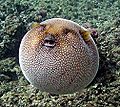Aposematism
In behavioral biology, aposematism, occasionally also called warning coloration, refers to the conspicuous coloration of animals that signals not only presence but also inedibility and/or defensibility to potential predators. Aposematism is thus the opposite of camouflage.
Aposematically colored animals are either defensible because they possess venomous spines or have other active defense mechanisms, or they taste unpleasant, are inedible or even poisonous. Usually a single encounter is sufficient for potential predators to develop a lifelong aversion to aposematically colored animals. In the case of butterfly caterpillars in particular, in addition to well-camouflaged caterpillars, one also finds those, e.g., the caterpillar of the alder bark owl, that signal their inedibility by means of conspicuous coloration. Other examples are the scorpion fish, the puffer fish, moray eels, poison dart frogs and also some native amphibians such as fire salamanders and toads.
Since predators usually have to develop aversion to aposematically colored species, individuals of such a species are repeatedly injured or even eaten. They serve as a teaching model of the predator. However, these costs of conspicuous coloration are distributed across all individuals in a population. The evolutionary development of aposematism, on the other hand, is still controversial. A warning coloration that first appears in an individual due to a mutation increases its predation risk compared to camouflaged individuals. One explanation is that inedibility or defensibility develops first and warning coloration develops only at higher population densities.
Some intrinsically edible and nondefensive species mimic the characteristics of aposematic species to deter potential enemies. This strategy is called mimicry.
Venomous octopuses can increase their aposematism when needed by having muscle cells additionally pulse the warning patterns, as in blue-ringed octopuses.
· 
Scorpionfish
· 
Pufferfish
· 
Moray eels
· 
Tree climbing frogs
· 
Fire Salamander
· 
Unken
·
Great blue ringed octopus (Hapalochlaena lunulata)
· 
Larva of the alder bark owl

Illustration by Henry Walter Bates (1862). The upper and the third row show Dismorphia species (mimicry), the second and the last row show Ithomiini species (aposematism).

The golden tree climber belongs to the aposematic colored animals
Questions and Answers
Q: What is warning colouration?
A: Warning colouration (or aposematism) is a form of animal communication in which animals use certain colors to let other animals know that they are poisonous or dangerous.
Q: How does it differ from camouflage?
A: Warning colouration is the exact opposite of camouflage. While camouflage helps an animal blend into its environment, warning coloration stands out and makes the animal more visible.
Q: What colors are usually used for warning coloration?
A: Warning colours are usually some combination of red, yellow, black and white.
Q: Who first proposed the idea of warning colouration?
A: Alfred Russel Wallace, a British naturalist, first proposed the idea of warning coloration in 1889.
Q: How do animals with warning colours advertise their defence?
A: Animals with warning colours move slowly and expose themselves to sight in order to advertise their defence. Along with this behaviour often comes a foul smell from chemical weapons as well.
Q: How do predators learn about the connection between colour and taste?
A: Tests show that predators learn about the connection between colour and taste by individual animals dying or receiving damage while on the attack.
Q: What types of mimicry can be based on warning coloration?
A: The two types of mimicry that can be based on warning coloration are Müllerian mimicry and Batesian mimicry.
Search within the encyclopedia
